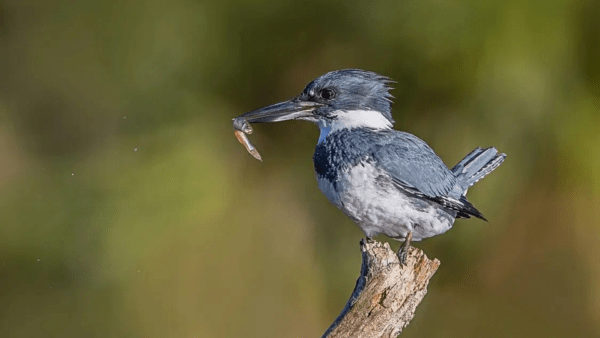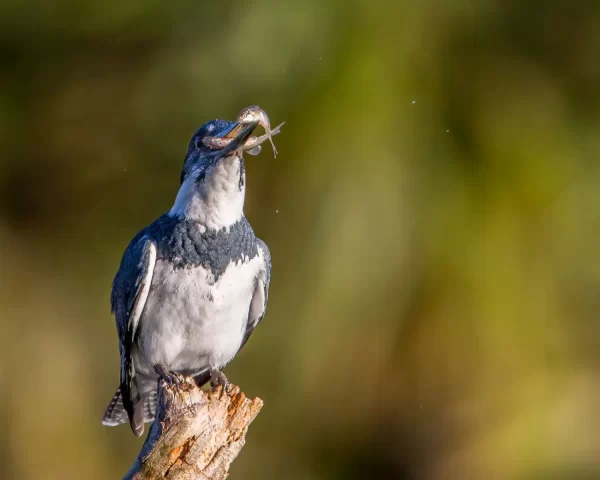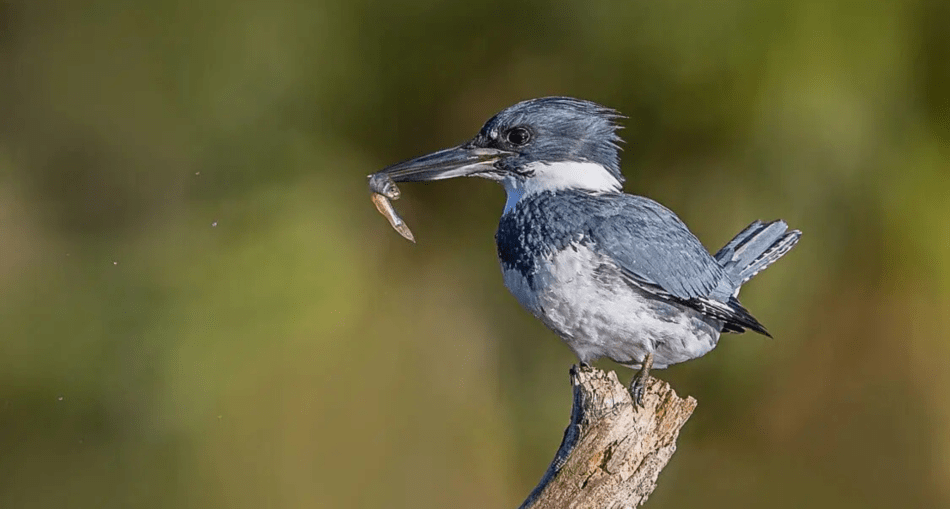In the verdant landscapes of Guyana, a fascinating bird swoops above rivers and lakes: they often give away its presence with a loud, rattling call.

The Belted Kingfisher [Photo: Andy Morffew]
This medium-sized kingfisher offers birdwatchers and nature enthusiasts a unique glimpse into the life of a remarkable predator.
APPEARANCE
The Belted Kingfisher is a striking bird with a large head crowned with a shaggy crest and a long, sharp beak.
Both males and females have a similar slate-blue head and wings, a distinctive white collar, and a blue band across the chest.
However, the female is surprisingly more colourful than the male, showcasing an additional rusty band across her belly, which adds to her visual appeal.
Juveniles are similar to adults, with both sexes displaying a rufous band, though it is more pronounced in females.
The unique dimorphism, where the female is more vibrant than the male, is rare among birds and makes the Belted Kingfisher even more intriguing.

The Belted Kingfisher [Photo: Andy Morffew]
DISTRIBUTION AND HABITAT IN GUYANA
This bird finds refuge in various aquatic habitats in Guyana, including rivers, lakes, and coastal mangroves.
It is particularly drawn to areas with clear, slow-moving water, where fish, its primary prey, are abundant.
The diverse landscapes of Guyana provide an ideal environment for hunting and roosting for the Belted Kingfisher, especially along rivers and near estuaries where the bird can easily dive for its meals.
FUN FACTS ABOUT THE BELTED KINGFISHER
- King of Fishers: The Belted Kingfisher’s name originates from an Anglo-Saxon term meaning “king of the fishes.”
- Reverse Sexual Dimorphism: The female’s bright colouring, which is unusual in bird species, makes the Belted Kingfisher one of the few birds where females are more vibrant than males.
- Tunnel Nests: Kingfishers dig uphill tunnels for nesting, providing an air pocket to protect chicks from potential flooding.
- Ancient Roots: Fossils of Belted Kingfishers date back 600,000 years, linking this bird to a rich prehistoric lineage.
HUNTING AND BEHAVIOUR
This bird is an expert angler. It spends much of its time perched near water, scanning for movement below. Unlike other bird species, which rely on scavenging or ground foraging, this kingfisher employs a sit-and-wait approach.
It watches for fish or small prey from its perch on a branch, pylon, or pier. Once a target is spotted, the bird hovers midair, beating its wings rapidly before plunging headfirst into the water to catch it.
This precise hunting technique not only shows off its impressive diving skills but also its ability to adapt to a wide range of prey.
Guyana’s waterways are filled with potential threats and competitors, but the Belted Kingfisher is far from timid.
It is highly territorial, defending its hunting grounds aggressively. If another bird, predator, or human enters its domain, it chases them with loud, chattering calls.
This fearlessness and its distinctive vocalisations make it a commanding presence, and locals in Guyana may easily recognise its characteristic rattling call.
DIET: CARNIVOROUS WITH A TWIST
As a carnivorous bird, the Belted Kingfisher primarily feeds on fish, ideally between 9 and 14 cm long.
However, its broad diet includes crustaceans, molluscs, amphibians, small mammals, and insects. Occasionally, it eats berries.
REPRODUCTION AND NESTING
This rattling kingfisher practices serial monogamy, forming pairs that work together during the breeding season.
The breeding season runs from April to May. They prepare their nests meticulously, excavating burrows in rivers or sandbanks.
Both males and females participate in this labour-intensive process, creating a tunnel up to two metres long. This slope ensures that any flooding pushes water away from the nest chamber, protecting the eggs and young chicks.
Once the nest is ready, the female lays six to seven eggs, which both parents incubate for 22 to 24 days.
The chicks are born naked and rely on their parents for food, primarily by regurgitating pre-digested fish.
The young birds are entirely dependent for the first few weeks, only venturing out after 27-35 days.
REFERENCES
- https://animalia.bio/belted-kingfisher?environment=110
- https://en.wikipedia.org/wiki/Belted_kingfisher
- http://www.iucnredlist.org/details/22683623/0







